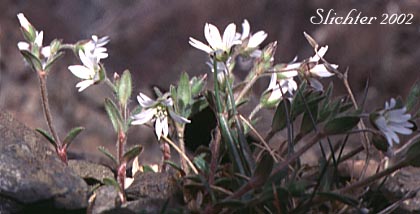
Alpine chickweed is a densely tufted perennial wildflower which grows in mats up to 15 cm wide. The mats are made of erect vegetative shoots. The numerous, heavily glandular flowering stems are erect and generally rise up to 10 cm high, although stems up to 25 cm high are possible. The stem leaves are similar to larger than the basal leaves. They are mostly narrowly oblong, oblong-lanceolate or spatulate in shape. They measure 10-15 mm long and 2-5 mm wide. Clusters of leaves or sterile shoots are very rarely found in the axils of the stem leaves.
The inflorescence consists of a single flower or an open cymne of 2-5 flowres. The margins of the floral bracts are green, rarely ever ringed with a light-colored membrane. The pedicels measure 10-20 mm long while the green to purplish sepals are 4-6 mm long. The calyx is glandular hairy. The white petals are notched at the tip and obcordate in outline. They are about 1.5-2 times longer than the sepals.
Field Chickweed: Cerastium arvense - Inflorescence 5-9 flowered. Floral bracts with membranous margins. Calyx with very short hairs. Leaves linear to narrowly lanceolate, measuring 10-30 mm long and 2-4 mm wide. Stem leaves with axillary whorls of small leaves or sterile branches.
Alpine chickweed is an alpine wildflower found amongst talus in glacial cirques or in shallow soils of alpine bunchgrass communities. Plants areare found between the elevations of 2600-4300 meters.
Alpine chickweed may be found from the Rocky Mountains of eastern British Columbia and Alberta south to Montana, Utah and Colorado. It may be found westward to eastern and central Idaho, the Steens Mt. in southeastern Oregon, and to California and Arizona.

Alpine chickweed amongst talus on the summit ridge of the Steens Mt.